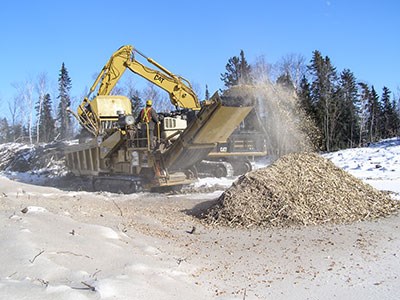The biomass market in Northern Ontario is heating up, literally and figuratively.
As fossil fuel-reliant remote communities prepare to scale back their consumption and transition to more sustainable energy sources, researchers and industry are looking to Europe for best practices and partnerships.
“We're looking at how we can collaborate for sustainability, sharing science, and leveraging best practices,” said Dawn Lambe, executive director for the Biomass North Development Centre in North Bay. “Their forest industry is incredibly sustainable and a key economic platform for them in economic hard times.”
In May, Lambe and a team of delegates from across the North headed to Sweden and Finland to meet with Nordic biomass experts, establish partnerships and exchange information.
“We don't have to reinvent the wheel,” said Lambe. “We learned about new technologies that are immediately of interest: manufacturing, boilers, furnaces, opportunity to develop new products.”
Stephanie Seymour was a part of the delegation, and has been incorporating European methods into her research at Lakehead University in Thunder Bay.
For her master’s degree, Seymour studied whether it was possible to heat remote communities with the biomass available within a 50-kilometre radius. Her conclusions were positive.
She specifically wanted to know if it would be feasible to use biomass in district heating, and used in Sachigo Lake First Nation and Lac Seul First Nation as test communities.
“In Scandinavia, we see technology there powering large cities and small farms,” said Seymour. “It's not common in Canada. Some communities have district heating but it's powered by oil or natural gas, and most communities have electric baseboards.”
Actually getting the available biomass materials into use would require infrastructure, materials and equipment, which Seymour said is the biggest barrier.
“The amount of wood isn’t necessarily the limiting factor,” said Seymour. “It's that there's not a lot of roads, or equipment, or a trained workforce, and that's where the economic and social pieces come in.”
Seymour is working on identifying these barriers and strategies to overcome them, and took inspiration during the trip overseas. One development was an arrangement with a Finnish company to help decide what specific technology would be best for the Canadian North.
Seymour said it's a chicken-and-egg scenario: “Do they wait for the market before they invest in new technologies or do they invest in new technologies before that comes?
“It’s one thing to put a district heating system in place but you need a whole supply chain to put wood into that system,” said Seymour.
She hopes the trip to Europe spurs some development from either side.
“Our end goal is a road map from fossil fuel dependency to renewable energy,” said Seymour.
In the coming months, Biomass North will continue conversations between their members and their new Nordic contacts. Lambe is optimistic the trip will lead to new developments in the short term.
“There's a huge amount of opportunity for us to learn from them and to kickstart the forestry sector in new ways,” said Lambe.




